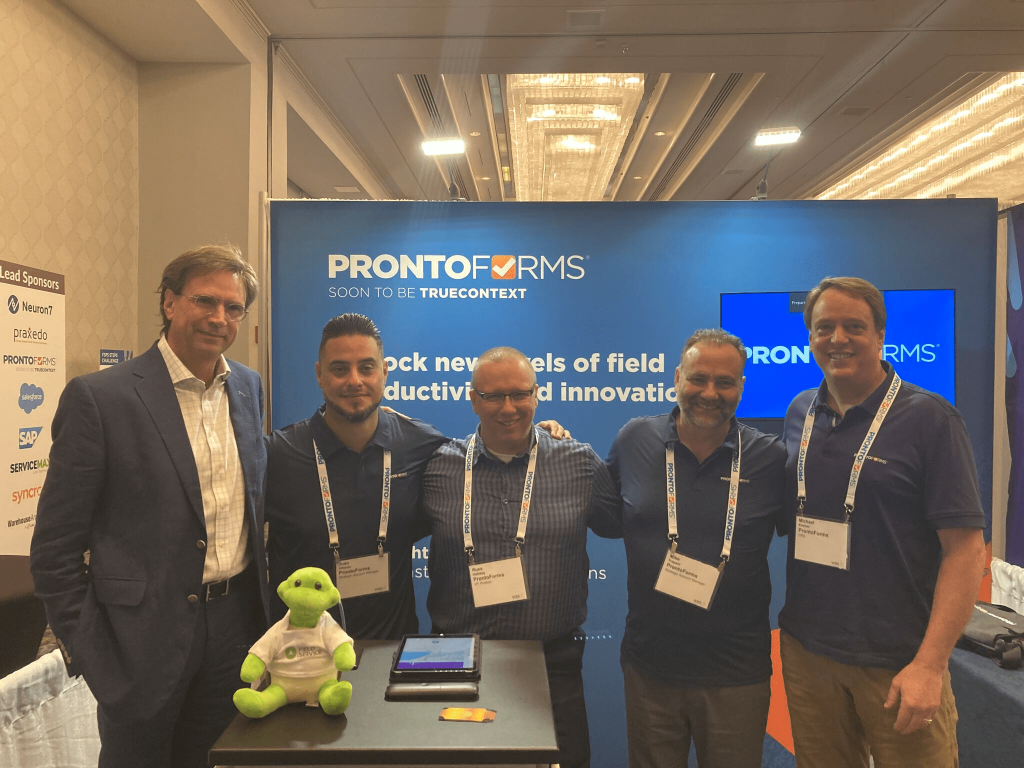AI, intelligent apps, and keeping the field engineer at the center of an evolving service landscape
Last week, I had the pleasure of attending Field Service Hilton Head, a conference that brought together service leaders across different verticals to discuss trends, best practices, and new technologies emerging in the industry.
I was fascinated by how similar everyone’s challenges were, regardless of business sector. From medical devices to HVAC manufacturers, utilities and energy to industrial food and beverage operators, everyone was facing the same needs and challenges. This common thread fostered a collaborative discussion that covered many different aspects of field service life.
Here’s what I saw at Field Service Hilton Head.
The role of technology in retaining & engaging the field service engineer
At the heart of every field service organization is the field service engineer (FSE). Often the conduit between the business and the customer, organizations don’t just see their field force as a barometer for customer experience but as a trusted advisor with a key role in the sales cycle.
FSEs are gold, not only because of their role in their organization but because of their increasing scarcity. There is a need to hire more FSEs to keep up with service demands. And in a challenging talent market, hiring the right one is important. More than filling skills gaps in your operation, finding the right talent plays a key role in staff retention. What steps can you take to retain them? By rethinking the way service is delivered. Start with the low-hanging fruit: the majority of polled FSEs say that the worst part of their day is administrative work and documentation. Unfortunately for them, the nature of their work, company, and regulatory bodies makes this an absolute requirement. In response, technology is stepping in to take this burden off FSEs.
Field Service Hilton Head examined a diverse range of potential solutions to these challenges. Envision an FSE repairing assets while guided by augmented reality. Stuck? Connect instantly to experts via remote support. Parts? Logistics and inventory apps predictively dispatch them to nearby depots before the asset even goes down. While fixing the issue, log work using intelligent applications that capture field data in an intuitive way – without it feeling like a separate strand of work – adapting to the specific workflow, delivering contextual data, and streaming it back immediately to operations.
This technology exists and was present at the show. Alvaro Pombo, TrueContext’s Founder and co-CEO, has expressed his goal of vendor collaboration. “We need to work together to help your teams. Challenge us to find ways to bridge your process gaps together with technology.”

Proactivity across all aspects of the service cycle
Proactive versus reactive service was a prevalent theme across all three conference days. With the demands of service always growing and not having the adequate resources to accommodate them, reactivity is becoming an unwanted standard. So, how do you do more with the same amount of resources (or worse, less)? I’ll summarize in two points: creating a change culture and leveraging technology to enact and support that change.
A fundamental understanding of your service workflows will identify areas of improvement and intuitive ways to address them. However, engaging in this process in a vacuum will lead to challenges within your organization. To properly define a service strategy, it must be done collaboratively, with considerations for all players across the board. A service leader must understand the key stakeholders within that workflow and how every step impacts them, working together to establish a culture of change leadership rather than change management.
Change leadership doesn’t mean just finding people who are open and ready to lead through change. It means working with them to define the strategy and understand the business motivations behind it and the goals of the change you’re trying to effect. By doing so, you will create a sense of empowerment and ownership amongst each stakeholder. By fostering this connection, you can select technology, tools, and optimizations that fit this defined strategy, all while considering the impacts they will have on your different stakeholders. There must be a focus on tools and technology that are specifically receptive to this strategy – and you must challenge vendors on how they fit and how they will help you move toward your vision.
AI: Here to stay but still being defined
Artificial Intelligence has emerged, and it will only continue to grow. Chad Barbour, Product Management Senior Director at Salesforce, opened his AI-focused keynote with the gripping statement, “Today is the slowest rate of change you’ll experience for the rest of your life.” We’re at the forefront of this technology in field service, and everyone was very excited to understand AI’s place in the field. What did I take away? Three concepts: predictability, analysis, and assistance.
The development of IoT in assets goes hand-in-hand with AI. By learning from existing service records and data while monitoring deployed assets, your AI platform will make predictions in every aspect of the service lifecycle. This will establish optimal predictive maintenance cycles, forecast service demand for efficient resource allocation, and manage spare part inventory to ensure that the right part is in the right place at the right time. AI will not only analyze your existing data to build these prediction models but also continue to learn from the data you feed it. By analyzing your service data, you will be able to model customer behavior to identify potential revenue opportunities, monitor failure trends based on common fail points, and track performance to pinpoint areas where corrective action and/or targeted training is needed.
The job site will also be impacted by AI, which will assist FSEs’ in-service completion. AI-powered remote monitoring of connected devices will recognize anomalies and potential issues in real-time, guiding technicians with troubleshooting, diagnosing, and triaging. It will assist in finding and creating knowledge articles based on previous successful work, further growing your living database of contextual information. FSEs will be dispatched logically, ensuring that traffic conditions, appointment priorities, and technician proximity and expertise are factored into the decision of who to send out best.
Conclusion
The present and future of AI in field service are incredibly promising, but one major takeaway was the need to balance it with the human element. As AI is brought into your organization and processes, it is critical to consider the way it will interact with your people. AI is here to empower your field force to do their job better – not to replace them. Leading organizations will continue to invest in AI and find smart ways to deploy it in response to business needs, with their people at the center.
Modern service leaders understand the key actors in their day-to-day. They strive to ensure their vision is created collaboratively and positively impacts them all. Historically, these actors have been the asset, the FSE, and the customer. However, discussions at Field Service Hilton Head centered on the emergence of a fourth component: the technology partner. By shifting your attitude from looking for technology to buy to technology to partner with, you won’t be searching for tools that fit your vision – you will be searching for tools that help craft it. There are many providers in the industry who are ready for the challenge now. To reiterate Alvaro’s call to action, “We need to work together to help your teams. Challenge us to find ways to bridge your gaps together.”




